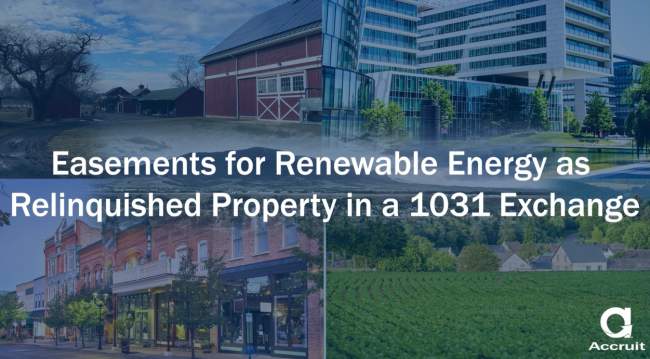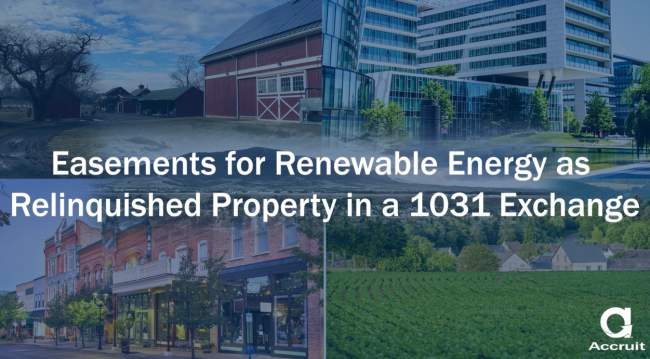There is often confusion surrounding 1031 Exchanges and related parties. A common misconception about 1031 Exchanges is that transactions involving related parties are prohibited. In reality, exchanges involving related parties are allowed, but come with stricter rules and oversight to ensure compliance with the tax code. Another point of confusion is what qualifies as a “related party”. Many assume it applies only to relatives, but the definition extends beyond family to include certain business entities and fiduciary relationships. Understanding related party rules is critical for investors looking to utilize a 1031 Exchange that is compliant with the tax code.
Who is a Related Party?
The Internal Revenue Code provides clear guidelines on who qualifies as a https://www.accruit.com/blog/1031-tax-deferred-exchanges-between-relate… party in 1031 Exchanges. Under Sections 267(b) and 707(b)(1) of the Internal Revenue Code, related parties include:
Immediate Family Members: Siblings, spouses, ancestors (parents, grandparents), and descendants (children, grandchildren).
Business Entities with Significant Ownership or Control: Entities where the Exchanger holds more than 50% ownership, such as corporations, partnerships, or trusts; two corporations that are members of the same controlled group; and corporations and partnerships with more than 50% direct or indirect common ownership.
Certain Fiduciary Relationships: Ex. An Exchanger and the fiduciary of a trust.
Affiliated Businesses: Entities that are directly or indirectly controlled by the Exchanger or their immediate family.
This broad definition ensures that any transaction involving individuals or entities with close personal or financial ties is subject to heightened scrutiny. https://www.accruit.com/blog/video-related-party-rules-1031-exchange”>T… Related Party Rules are designed to prevent potential abuse, such as shifting tax liabilities or inflating property values in ways that undermine the intent of a 1031 Exchange.
It’s also important to note that these relationships are closely monitored to ensure the legitimacy of the transaction. If an exchange involving related parties fails to meet the requirements, the transaction may be disqualified, and tax deferral could be denied. Understanding these parameters is essential for Exchangers considering transactions with related parties.
The Tax Reform Act of 1984
Before the 1980s, Exchangers could potentially conduct a 1031 Exchange with related party real estate to manipulate property values or defer taxes improperly. For instance, two related parties might exchange properties where one has experienced significant appreciation, in order to shift tax liabilities. To address this issue, Congress strengthened the statute. The Tax Reform Act of 1984 introduced critical changes to related party exchanges, implementing safeguards to ensure these transactions were legitimate and not used to evade taxes.
Direct Related Party Exchanges
The introduction of the two-year holding period under the Tax Reform Act of 1984 fundamentally reshaped the landscape of 1031 Exchanges involving related parties. This rule only applies to a direct swap, which occurs when both parties directly swap properties with one another simultaneously and stipulates that both parties must hold their new properties for at least two years following the transaction. If either party disposes of their exchanged property within the two-year window, the tax-deferral benefit is retroactively revoked, and the original capital gain becomes fully taxable in the year the property is transferred. Again, this rule is only true in a direct exchange between related parties and does not apply if an Exchanger sells their Relinquished Property to a related party or purchases their Replacement Property from a related party.
Exceptions to the Two-Year Rule
There are specific circumstances where the two-year holding period rule does not apply. One circumstance involves the death of an involved party. If one of the parties involved in the exchange passes away during the two-year period, the rule is waived. Another exception includes situations like eminent domain or natural disasters that force the disposition of a property. For example, the holding period requirement may be waived if a government agency acquires the property for public use or a disaster makes the property unusable. Lastly, the rule does not apply if the IRS determines through an audit that the transaction was not structured to avoid taxes, requiring the Exchanger to demonstrate legitimacy of their intent for the transaction.
Relinquished Property to Related Party Considerations
Selling Relinquished Property to a related party in a 1031 Exchange is generally more straightforward than other related party scenarios. Unlike direct exchanges, there are no specific holding period requirements if an Exchanger sells their Relinquished Property to a related party in a 1031 Exchange. As long as the sale of the Relinquished Property complies with IRC Section 1031 guidelines, such as proper use for business/investment purposes and adherence to identification and timing rules, it can proceed without any additional considerations.
Considerations for Buying Replacement Property from a Related Party
Buying Replacement Property from a related party, however, involves stricter requirements. In order for this transaction to qualify under 1031 Exchange rules, the related party selling the Replacement Property must also be conducting a 1031 Exchange. In this case, the Replacement Property being acquired would simultaneously serve as the related party’s Relinquished Property. If the related party is not conducting a 1031 Exchange, the transaction would be disqualified from 1031 Exchange treatment under IRS regulations.
Why Related Party Rules Exist
The two-year holding period and Related Party Rules from the 1984 amendment were designed to protect the integrity of the tax system. Before these changes, related party transactions in 1031 Exchanges could be misused for tax avoidance. When it applies, the holding period seeks to avoid improper basis shifting between the related parties. For example, consider two related parties: Party A and Party B. Party A owns a property with a low adjusted basis while Party B owns a property with a high basis. If Party A exchanges their property for Party B’s property, Party A transfers their low basis to Party B, avoiding substantial taxation upon sale. Party B could then sell the acquired property after the exchange, incurring minimal taxable gain due to the higher basis, which undermines the intended purpose of a 1031 Exchange.
By addressing ambiguities surrounding these exchanges, the amendment boosts confidence in the fairness of the tax code. https://www.irs.gov/pub/irs-pdf/f8824.pdf”>IRS Form 8824 reflects the heightened scrutiny of related party exchanges and outlines steps for Exchangers to ensure compliance. Specifically, lines 7-11 require Exchangers to disclose detailed information about the related party, the nature of the relationship, and whether the Relinquished and Replacement Property(ies) were transferred to/from a related party. These disclosures help the IRS identify potential compliance issues within a related party exchange.
Considerations for Related Party 1031 Exchanges
For Exchangers considering a 1031 Exchange that involves a related party, here are some key considerations:
Plan for the Two-Year Holding Period: Ensure that both you and the related party can hold the exchanged properties for at least two years where it is applicable. Disposing of property before the two-year period will trigger immediate tax consequences.
Document the Transaction: Maintain clear records of the exchange, including appraisals, contracts, and any correspondence with the related party. This documentation will be critical if the IRS scrutinizes the transaction.
Seek Professional Guidance: Related party transactions are complex and monitored closely by the IRS. To ensure compliance with all regulations, consult tax and legal advisors and work with a Qualified Intermediary like Accruit, who specializes in 1031 Exchanges.
By understanding these considerations, Exchangers can confidently navigate the complexities of related party transactions while preserving the benefits of a 1031 Exchange. With careful planning, thorough documentation, and professional support, Exchangers can avoid common pitfalls and achieve a successful investment strategy.
The material in this blog is presented for informational purposes only. The information presented is not investment, legal, tax or compliance advice. Accruit performs the duties of a Qualified Intermediary, and as such does not offer or sell investments or provide investment, legal, or tax advice.









